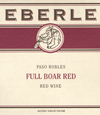 |
|
Wine Details
Price:
$12.00 per bottle
Description:
The best kept secret in the Passage of the Oaks! Predominantly Cabernet, our non-vintage Full Boar Red gets its versatile characteristics from splashes of Sangiovese, Barbera and Chardonnay. Definitely the wildest country wine your table’s ever seen.
|
|
|